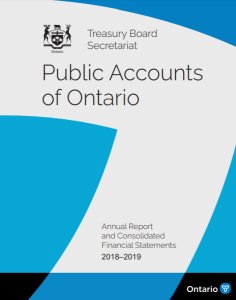Reading the Fine Print: The Real Impact of the Ontario Public Accounts
 The tabling of the 2018-2019 public accounts officially closes the Ford government’s first fiscal year in power. Year one’s fiscal projections saw constant re-adjustment, which is no surprise for a new government after a system-wide program review. Today’s report showed the deficit declining from an initial commission recommended $15 billion, to $14.5 billion in the Fall Economic Statement, falling to $11.7 billion in the 2019 budget, and now the final number for the fiscal year of $7.4 billion.
The tabling of the 2018-2019 public accounts officially closes the Ford government’s first fiscal year in power. Year one’s fiscal projections saw constant re-adjustment, which is no surprise for a new government after a system-wide program review. Today’s report showed the deficit declining from an initial commission recommended $15 billion, to $14.5 billion in the Fall Economic Statement, falling to $11.7 billion in the 2019 budget, and now the final number for the fiscal year of $7.4 billion.
How Can the Number Be So Low?
Cutting a $15 billion deficit in half in one fiscal year is next to impossible. So, what is going on here?
The Ford government did undertake high profile spending reductions like returning the Ontario Student Assistance Program to a loan-based structure. However, most announced savings materialize in later years, meaning the standard response that “cuts” have led to the 2018-19 deficit reduction is not the right one.
Instead, three major factors combined to provide substantial deficit reduction, quite separate from the government’s expected operating savings:
- Capital Spending Delays – The previous Liberal government embarked on an ambitious infrastructure plan to spend some $190 billion over 13 years on capital projects such as hospitals, schools, and transit. At the same time, the $30 billion Investing in Canada Infrastructure Program (ICIP) funded by all three levels of government is rolling out over the next 10 years. With such high demand, and a critical shortage of skilled trades, there is only so much capacity in any year. As a result, $1.5 billion of this expected spending didn’t go out the door. The money gets shuffled to future years and the corresponding savings will disappear as a result.
- Readjusted HST Accounts – The Harmonized Sales Tax is tricky accounting with both federal and provincial sales taxes collected by the federal government, and then rebated to the appropriate province. In addition, input tax credits apply to the HST, meaning businesses recover some of the HST they have paid for commercial activities. Due to all the moving parts, HST projections are often wrong, with readjustments happening frequently. This time, the Ontario government got back an additional $1 billion from 2017 and 2018, updating the deficit numbers both this year and last. Though possible, they cannot rely on this money to show up again in 2019-20.
- Increased Corporate Income Tax Revenue – Like the HST, Corporate Tax Revenues were always difficult to project, and are even more challenging with the new accelerated capital cost allowance policy endorsed by the federal and provincial governments. This policy incented businesses to make investments now, and many did. The increased investments meant the economy got an artificial bump. More business investment means more corporate income tax revenue. Of course, an increase of $1.5 billion above estimates suggests Ontario’s economy is doing well, but again, this may only be a temporary boost from an early rush to take advantage of the capital cost allowance.
What Does it Mean for You?
Based on today’s numbers, it could be easy to assume that the government is ahead of schedule on its deficit reduction plan and that it’s smooth sailing ahead. A reduction in the deficit is good news, but many of the factors contributing to the 2018-19 public accounts are likely a one-time bump. Austerity is very much still on the Ford government’s agenda, and the provincial purse will not open anytime soon.
In fact, the government will have an increasingly difficult time showing forward progress each year given the one-time nature of the benefits in 2018-19. If the new Minister of Finance wants to be able to say the government has reduced the deficit next year, more work needs to be done. After all, the deficit was supposed to be $10.3 billion next year, which would be a nearly $3 billion retreat if their projections hold true.
You can find the 2018-19 public accounts here – https://www.ontario.ca/page/public-accounts-ontario-2018-19
